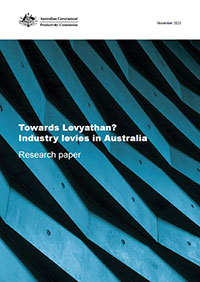Towards Levyathan? Industry levies in Australia
Research paper
Released 12 / 12 / 2023
Industry levies – narrowly applied, sector-specific taxes – are proliferating in Australia. There were four industry levies in 1960, 26 in 1980 and today there are 248.
This paper explores the evolution of Australian industry levies since Federation, how they represent a growing form of micro-taxation in Australia, and the potential factors that have supported their proliferation.
The paper also provides a framework for assessing the public policy case for individual industry levies.

Errata
This errata was issued on 21 December 2023. Changes have been made to Appendix B. This includes removing two levies – the Bobby Calves Transaction Levy and the Ratite Slaughter Levy – which were captured by other entries in the stocktake. The Bobby Calves Transaction Levy is included in the overarching Cattle Transactions Levy entry, and the Ratite Slaughter Levy is made up of the individual Emu Levy and the Ostrich Levy entries in the stocktake. Two additional levies were also added – the ShellMAP Levy and the South Australian Oyster Research Council Levy.
The Commission also revised revenue figures on six levies – the Mining Rehabilitation Fund Levy; the Police, Fire and Emergency Services Levy; the Qleave Levy; the Regional Broadband Scheme Levy; the Waste levy (NSW); and the Waste Levy (WA). A change in approach to rounding also led to some minor adjustments to the revenues attributed to a number of other levies. Further updates to the industry levy stocktake will be made available through future annual Trade and Assistance Reviews.
Media release
Growing number of micro-taxes risks productivity growth
The rise of industry levies – narrowly applied, sector-specific taxes – is creating an increasingly complex and inefficient tax system that risks limiting productivity growth, according to Productivity Commission research released today.
The report finds that the number of these industry levies has quietly grown from 26 to 248 since 1980 to become the ‘long tail’ of Australia’s tax system, collecting less than 2% of overall tax revenue.
“Without anyone noticing, these micro-taxes have compounded into a bureaucratic ‘Levyathan’. Limiting their growth in favour of more efficient taxes is a simple, actionable reform that could make a material difference to productivity growth,” said Deputy Chair Dr Alex Robson.
Levies were originally introduced in the agriculture sector to raise funds for activities that benefit producers, but they are now being imposed by policymakers on a wide range of industries, in some cases as a way of simply raising general tax revenue.
While many levies are nominally collected to cover the cost of government regulation or mitigate environmental costs, these goals could often be pursued more effectively and efficiently through the broader tax system.
“Taxes work best when they are simple and efficient – but many industry levies are relatively expensive to collect, unnecessarily distort business activity and waste the time and resources of business and government,” said Dr Robson.
The report highlights some startling examples of this inefficiency, including a list of 70 agencies around Australia involved in administrating or collecting industry levies and a stocktake of levies ranging from the billion-dollar Major Bank Levy to the $25.62 in revenue raised from levies on wild goat carcasses harvested as game in 2022.
The analysis raises concerns that policymakers may be using levies as a politically expedient way of raising additional revenue that can be managed by an individual portfolio minister or department, with little regard for the impact they may have on the tax system as a whole.
“The cost of levies is almost invisible to the average taxpayer – people notice when income taxes rise, but no-one appears to notice when a levy is passed on by their insurance provider. It is little wonder then that policymakers might see a new levy as a good way to raise revenue even when better policy options might be available,” said Dr Robson.
The report presents a rigorous, straightforward framework for determining when a new levy can be justified.
“If governments can’t restore policy discipline to the design and implementation of these levies, our chance of a more efficient tax system that fosters productivity growth risks death by a thousand micro-taxes.”
Media requests
Media team – 02 6240 3330 / media@pc.gov.au
Contents
- Preliminaries: Cover, Copyright and publication detail, Executive summary, Acknowledgements and Contents
- 1. The evolution of industry levies in Australia
- 1.1 Industry Levies in Australia
- 1.2 Evolution of Industry Levies
- 2. A framework to assess the policy case for industry levies
- 2.1 Industry levies appear to conflict with good tax system design
- 2.2 A framework to assess the policy cases for individual industry levy proposals
- 2.3 Case study
- 3. Explaining the proliferation
- 3.1 Community attitudes
- 3.2 Institutional considerations
- 4. The effectiveness of levies and data
- 4.1 The levy evidence base
- 4.2 The Commission’s empirical approach
- 4.3 Policy considerations to improve the evidence base
- Abbreviations
- Glossary
- References
Appendices
- A. Consultation
- B. Levy stocktake
- C. Business Longitudinal Analysis Data Environment (BLADE)
- D. Mapping levies into BLADE
- E. International comparison
- F. Biosecurity Protection Levy case study
We value your comments about this publication and encourage you to provide feedback.